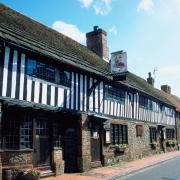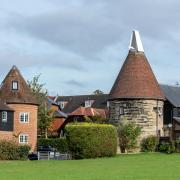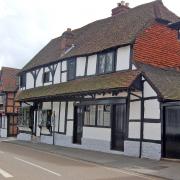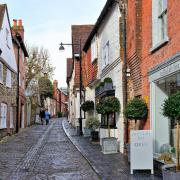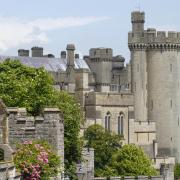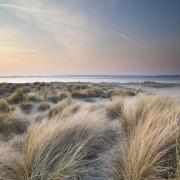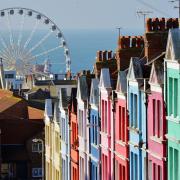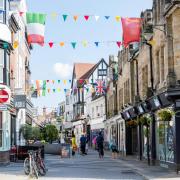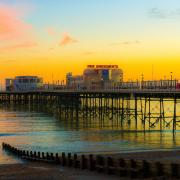Clive Agran hears tales of smuggling, lucky stones and wartime derring-do when he pays a visit to Alfriston
Property in Alfriston (pronounced All-friston) is expensive, according to Bill Rendall, honorary secretary of the Alfriston and Cuckmere Valley Historical Society (ACVHS). Consequently, the pretty village perched on the Downs roughly halfway between Eastbourne and Newhaven is mostly populated with well-to-do retired people. There might have been a wider socio-economic mix if more properties were sold for the sort of price the National Trust paid for Clergy House back in 1896. It was their first ever acquisition and was a snip at £10. Even when adjusted to today's prices that's only a very affordable £600 or thereabouts.
Regular readers of this series may recall Kevin Gordon showed us around Seaford. A past chairman of ACVHS, he has found time in his hectic schedule to escort me through the narrow streets of Alfriston. They're not too busy right now but it can be a squeeze at the height of the summer when visitors flock here to soak up the charm. The tight high street can become something of a bottleneck and a controversial scheme involving dreaded traffic lights was trialled last autumn but hasn't yet, as it were, been given the green light.
Immediately we exit Bill's lovely old house in West Street, Kevin draws my attention to a huge stone embedded in a wall opposite. Left by retreating glaciers in the ice age, big rocks like this were thought to possess magical powers and were often deployed on boundaries to ward off evil forces. This one seems to be working as my car's not been given a parking ticket while we've been chatting.
Lying roughly halfway between Canterbury and Chichester, Alfriston was a popular stopping-off spot for pilgrims, whose preferred hostelry was The Star. Originally built by the Abbot of Battle sometime in the 16th century, it later morphed into an inn. Curious carved figures decorate the doorway including seven little green pagan men and a couple of saintly characters. There's a more substantial figure propped up against a wall just along the road. It's a figurehead of a red lion that once adorned a Dutch ship that sank at the Battle of Beachy Head and was washed up on the nearby shore.
As was the case in so many villages along the south coast, smuggling flourished after the Napoleonic wars. Alfriston was particularly well suited to this nefarious activity as the adjacent Cuckmere (pronounced Cook-mere) is a rare river in having no settlement at its mouth thus rendering it less observable.
Ye Olde Smugglers Inne acknowledges this turbulent chapter of local history while the 14th-century George Inn completes the trio of historic pubs. The latter suffered a bad fire in 1939 and Kevin points out that the Horsham slates, which can be seen on many of the old buildings, are missing from the middle.
There used to be a fourth pub, The Steamer Inn, which lent its name to the Steamer Trading Cookshop that opened its first ever premises here in 1985 but recently moved out. We pop into Much Ado Books and chat to Nash Robbins, an affable American who, together with Cate Olson, moved here from Boston about ten years ago. Why? "We like the weather. There's no need for air conditioning or a shovel to shift the snow."
A shop has apparently existed on the site presently occupied by The Village Store since 1406. The counter is about 125 years old and the shop is as full of nostalgia as it is of useful items. There's even a rare Lamson which, in case you're unfamiliar with the name, is a rapid wire and pneumatic tube delivery system for whizzing cash around the premises.
Over the road is The Old Bank. Built in 1901 it was reputedly the smallest purpose-built bank in the country. It used to be a Lewes Old Bank and then a Barclays but has now sadly gone the way of most high street banks.
In Market Square Kevin explains that Alfriston received its market charter in 1405 and developed into a busy and bustling market town. The market cross, next to which traders would do deals 'beneath the eyes of God', is the only one of its kind in East Sussex.
Sadly, it has suffered a couple of mishaps. In 1919, a Canadian soldier, presumably drunk, climbed on top of it and knocked a few bits off. And then in the 1950s a lorry bashed into it.
Look closely at the base and you can see a few more scars where the local butcher sharpened his knives.
We slip down a twitten and into what was a non-conformist chapel and is now a communal hall. A plaque outside refers to "… a fracas on 11 December, 1831 when Charles Brooker, senior trustee of the Congregational Church, used supporters to depose a rival minister and re-instate the Revd. George Betts." Clearly, Alfriston wasn't always the peaceful place it is today.
A couple more reminders of more violent times confront us as we reach the Tye, or village green. A large World War II mine that washed up on the nearby beach is now deployed as a receptacle for cash donations to charity. And there's the Gun Room, which housed cannon to protect the village from the marauding French.
Impressive St Andrew's Church now stands before us. Built of knapped flint around 1360 and known as the 'Cathedral of the Downs', it is surprisingly large, a fact which puzzles Kevin. Normally large churches are associated with a status-conscious lord of the manor but there was no lord of the manor here. One of only 16 churches in England where the bell ropes hang down into the main body of the building, the south transept has stained glass windows by the famous Charles Eamer Kempe. Look for the wheatsheaf symbol in the bottom corner.
The spire is presently undergoing repairs. Having to woodpecker-proof the replacement oak shingles with metal backing has contributed to the overall cost of £100,000.
The round graveyard may indicate Saxon origins and contains several famous residents. The former Chancellor of the Exchequer, Denis Healey is buried alongside his wife Edna, the author. Sir Peter Medawar, whose work on graft rejection and immune tolerance was critical to the success of organ transplants, is here. And finally there's Bill Sparks, the last of the Cockleshell Heroes who raided the German-occupied French port of Bordeaux by canoe to attack enemy shipping in 1942 in one of the most daring and dangerous special operations of World War II.
The nearby Clergy House was the comparatively modest home of the local parish priest. Although doubtless a late-19th century estate agent would have described the Wealden Hall house with its thatched roof, wattle and daub walls and rare chalk and sour milk floor as being in need of modernisation, we should be grateful to the National Trust for preserving such a precious piece of history.
Whether the oak leaf carved into one of the many beams in the house inspired the National Trust to adopt it as their logo is a question not even the remarkably knowledgeable Kevin can answer.
www.alfriston-village.co.uk/historical-society
More…
- A closer look at the history of Hove - We take a guided tour of Brighton's often-overlooked neighbour, Hove










